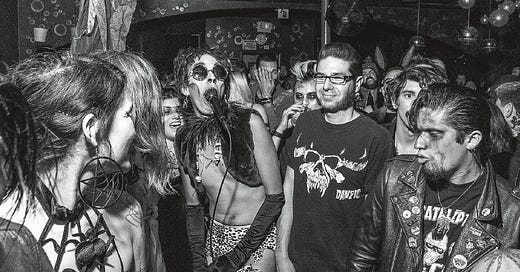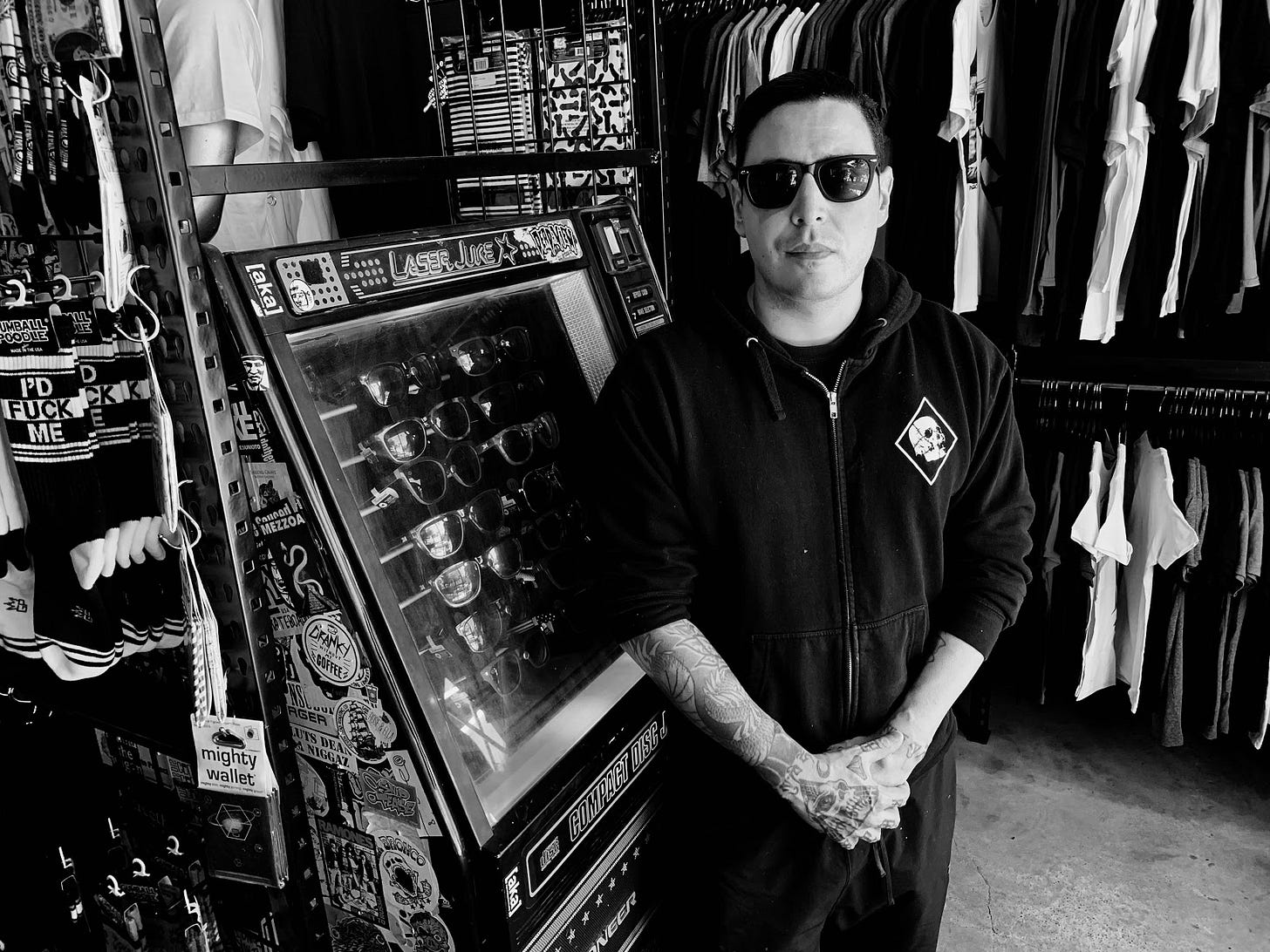Documenting the children of the night
Javi Nunez’s new book, Hemlock: A Night of Deathrock, guides you through the glorious gothic shadows of America’s sunniest city
It just so happens that I’m listening to the audiobook of Bram Stoker’s Dracula while on my way to interview Javi Nunez. I’ve been meaning to sink my teeth (heh) into the famous gothic epistolary novel again for some time, and it does not disappoint.
Near the beginning of the story, Count Dracula dines with his newly-arrived houseguest, the business solicitor Jonathan Harker, who’s becoming increasingly unsettled by the Count’s strange demeanor. Suddenly, their conversation is interrupted by the sound of howling wolves. This is the scene where the Count delivers his most famous line:
Listen to them—the children of the night. What music they make!
I get chills at that line, not only for its grim beauty, but at the knowledge that Stoker seemed to have inadvertently established the foundation of goth as an artistic subculture in a single line.
And if anyone knows a thing or two about children of the night, it’s Javi Nunez, founder of the goth club night, Hemlock.
Hemlock’s foundation was set in 2017, when Nunez asked Blonde Bar (RIP) owner Allen Colaneri if he could spend his birthday DJing at Colaneri’s bar.
“I wanted to do a night where I just play goth stuff and deathrock,” Nunez says. “And [Colaneri’s] like, ‘Yeah that sounds great, Javi. But what's deathrock?’”
Colaneri gave Nunez a Monday night, which Nunez dubbed “Hemlock: A Night of Deathrock.” Intended to only be a one-off sort of thing, Nunez was surprised how voracious and immediate the response was.
“We kind of hit it out of the park,” Nunez says. “People liked it and they wanted more. That's where it turned into a recurring thing.”
Thus, Nunez’s goth club night Hemlock was born (or unearthed, depending on how evil you are).
From 2017 to 2020, Nunez ran Hemlock with Robin Roth (DJ and director of San Diego’s longest-running goth nights, Sabbat) and Jamie Ryckman. As mentioned, what set Hemlock apart from other goth nights in town was its focus on deathrock—a subgenre that fuses the genre’s dark theatrics with rock and punk-metal grime. It’s still dancy, but not in the industrial/Matrix/rave sense that one might imagine when picturing a goth night. If you like drinking beer in a beat-up, studded leather jacket while listening to bands like Christian Death, The Gun Club, 45 Grave, Alien Sex Fiend or The Cramps, Hemlock was heaven (or hell, depending on how evil you are).
As Hemlock nights grew, Nunez began booking live bands and making custom, one-of-a-kind merch to commemorate each event, including posters and silk-screened tees (which he produced at aka, a North Park print shop Nunez has co-owned for the past 10 years). Those extra touches brought people back, and a Hemlock community quickly formed. However, the amount of work Nunez was putting into each event—in addition to his regular duties at his full-time job—proved to be too much even for the most passionate of passion projects. So, wary of stretching himself too thin, Nunez ended Hemlock in 2020, just before COVID hit.
“Burnout is real,” Nunez says with a touch of melancholy in his voice. “I'm here at my shop, seven days a week. My day to day wasn’t slowing down and having to tack on [Hemlock], it would get stressful. I kind of just decided to go off on a high note. Take some time to step back and reassess.”
With some more time on his hands, and inspired by his experience creating a zine, Nunez set out to chronicle Hemlock’s three-year run as a full-on book. The result? Hemlock: A Night of Deathrock. The project has taken Nunez most of the pandemic to put together—a heady process that involved collecting photographs, writing, learning InDesign, and navigating the nuances of publishing from scratch. He may have even modified his attire to fit his goth-publisher/pandemic lifestyle.
“I’ve gone full-on into leisure goth,” Nunez says, nodding to his outfit: black track pants and a Hemlock hoodie. “This is my club wear now.”
Now, nearly a year in the making, Nunez’s pandemic project is complete.
“When I was deciding to kind of put an end to the Hemlock events, I was like, 'What would be the best way to kind of encapsulate everything that we've done over the past years?’” Nunez says. “I really wanted to make sure it was something you can hold, something that can be referenced years from now, something where I can say, 'Holy shit, man, at least for this point in time, that's all of what [Hemlock] was and it was pretty cool.’”
Hardcover-bound and brimming with stunning black and white photos from San Diego photographers Oscar Aranda, Jeff Morris and Erin Shores (among others)—as well as flyer art, and original writing—Hemlock is like your high school if your yearbook worshipped the devil. The images are breathtaking, an exquisitely lurid exhibit of big hair, bare skin, makeup, leather, lace, straps, passion and love. Even though I was at some of these events, it’s still kind of hard to believe that these were shot in San Diego,and not some London dungeon in the ‘80s. In that sense, Hemlock also acts as a historic document—or, as Nunez believes it to be, the first book about San Diego alternative club culture.
“I don't think there's been one prior,” he says. “If there are, sorry.”
Although Hemlock primarily focuses on Nunez’s deathrock club night, it also serves as a love letter to the community at large, including the DJs, bands and people that make the city’s goth scene remarkable. It’s also incredibly supportive, and Nunez is quick to credit everyone around him as the reason for Hemlock’s success.
“I’m just a guy who prints T-shirts,” he says.
Regardless of your appreciation of everything dark, spooky, or thrilling, it’s impossible to finish Hemlock and not feel as if something inside you has become unlocked. Perhaps it’s some repressed desire, morbid fascination, or a mixture of both (which, if you think about it, is pretty much what Dracula is about), but Hemlock captures the appeal of what happens when you indulge your darker side, and rather than being scary—as normies may fear—but fun, sexy, and romantic (in fact, Nunez tells me that he first became acquainted with goth by perusing the ‘00s dating site gothicmatch.com in the early ‘00s).
But most importantly, the Hemlock: A Night of Deathrock captures the welcoming aspect of the scene. The book is nothing if not a product of community support, love and dedication.
“Even if you're not into the darker aspects, but if you're into community and a sense of kind of home and belonging—this little scene is really good about that. You can walk in with a Tommy Bahama shirt and flip flops, and if you're having a good time, you know, come on in.” Nunez pauses, and laughs. “You might get questioned about said Tommy Bahama shirt but no one's going to be mad at you.”
Get your hands on a copy of Hemlock: A Night of Deathrock at the release party on Saturday, June 19, at The Casbah.
THE WEEKLY GOODS
Read this
Last month, I refinished my deck, and I wrote about the experience for PACIFIC Magazine. I know what you’re thinking: quit talking and let me read that shit right now! Okay, okay. Without further ado, here it is.
Listen to this
At the beginning of this year, I interviewed Al Howard about his ambitious music project where he set out to write 100 songs in a year. Well, folks, he did it! The final entry “Solace” is simply stunning, a soulful coda sung by Madeline Tasquin. For me, the song has an exquisite, laidback finality that’s similar to Auld Lang Syne, and I doubt anyone who’s followed this project through the year we’ve had will be able to withhold their tears. Fantastic job, Al, and everyone who was involved with this project.
Watch this
I’m a horror fan, so obviously, George Romero is one of my favorite directors, and part of what I love about him is his blue-collar approach to filmmaking. Even though he practically invented our modern concept of zombies, he spent a lot of his early career making commercials and industry PSAs in Pittsburgh. One of such was a 51-minute PSA for a Lutheran Society about ageism and the fears associated with growing old called The Amusement Park. Long thought to be lost to the annals of time, some plucky film restorers found a print in 2017, cleaned it up, and released it on Shudder yesterday. And having seen all of Romero’s films, let me say that The Amusement Park is fucking terrifying. The film follows an elderly gentleman stuck in a surrealist nightmare where nobody pays attention to him, he’s constantly tricked and robbed, and treated like an idiot. Upon seeing the finished product, the Lutheran Society was like, “uhhhh what the fuck?” and the film was shelved for decades. But it’s really good. Honestly, if someone found a lost George Romero and it turned out to be eight hours worth of footage of him meticulously peeling a hard-boiled egg, I’d still watch it. Luckily, The Amusement Park is not that.
Peep this
Totino’s, the infamous purveyors of the pizza roll, is using an image I created on their social media. The picture is a result of a segment called “You ‘Shop Bro?”—a photoshop contest that my friends and I on our weekly Youtube show, Polyester Blend. It was Poly Blend’s host, Ryen Schlegel, that sent them the image, so he’s getting all the credit, but that image is a 100% genuine Ryan Bradford. My favorite part is if you look closely, you can see me doing thumbs-up with both hands because I don’t know how to pose for pictures. I can’t remember the prompt of this particular image, but Totino’s pizza rolls often show up in my photoshops, regardless if they’re for a contest or not. Anyway, I’m a star now. This is my peak.
Got a tip or wanna say hi? Email me at ryancraigbradford@gmail.com, or follow me on Twitter @theryanbradford. And if you like what you’ve just read, please hit that little heart icon at the end of the post.
Julia Dixon Evans edited this post. Thanks, Julia. Go follow her on Twitter.











